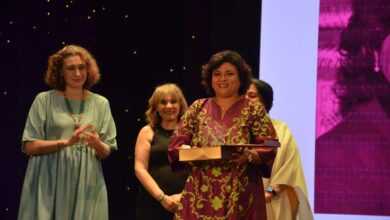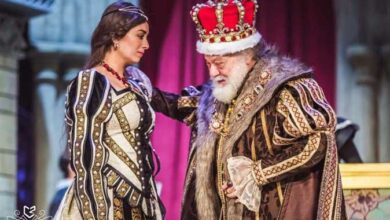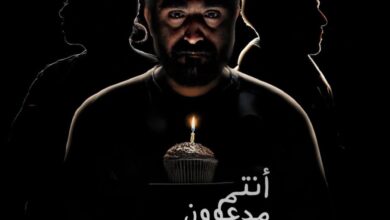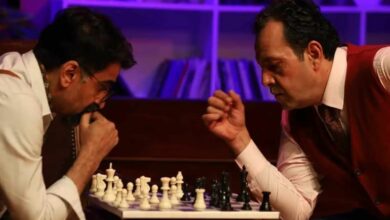After six days of dance performances and plays, the third edition of 2B Continued Laboratory and Festival ended its run to positive reviews. Most events took place in downtown's Falaky theater, starting Thursday 13th of January and closed on Tuesday 18th, and some parallel events were organized by HaRaKa and studio Emad Eddin Foundation to celebrate the theater and contemporary dance festival.
“Moving from an idea to a performance is a whole process,” said Nevine al-Ibiary, the festival director. “My vision for the 2B Continued Laboratory and Festival is that young artists come to the lab with an idea. During the lab, the idea is developed and matured under the mentorship of experienced professionals and then realized in a performance in the festival.”
According to al-Ibiary, the lab is a place where creativity is respected, supported and realized under the supervision of professionals who believe in new talents and in offering equal opportunity to create. “These professionals were generous enough to share their time and experience with these young talented artists for three months, guiding them towards the final realization of their visions,” Al-Ibiary added.
The festival presented two contemporary dance pieces, two choreographers, two theater performances, two directors, four light designers, four scenographers and four stage managers.
Hassan al-Geretly, theater mentor, explained that his “role in this festival has been to participate in the choice of the two projects to be produced, and then to suggest the adaption of the texts into colloquial Arabic, because the literal classical Arabic translation does not reflect the spirit of the two Ionesco plays that deal with the absurdity of everyday dialogue between people.”
“I took part in rehearsals without intervening directly,” he added. “I tried to consolidate the work of the two directors, each according to his or her vision and work method. My suggestions were related to clarifying and consolidating the role of gestures in relation to the spoken word, in an attempt to avoid redundancy.”
“This experience is grounding [the young artists] with a concrete relationship to an art project and a way to put strong foundations in their own development for the future,” Laurence Rondoni, contemporary dance mentor, pointed out. “2B Continued offers something essential for young artists as well as for the audience.”
Directed by Ahmed Shawky al-Bohy, the play “How to Get Rid of It” was one of the highlights of the festival. “We presented one of Eugene Ionesco's most prominent texts that reflects the vocabulary of theater of the absurd,” explained al-Bohy, “a field where Ionesco was considered one of the most important pillars.”
"Frenzy for Two," a play directed by Yousra al-Sharkawy, explores the relationship between a man and a woman who lived for many years in disagreement about whether it is appropriate to open or close the window and whether it is best to go out or stay indoors. “As a backdrop to this dispute, one hears in the background echoes of rebellion, the roar of machine guns, the explosion of bombs, screams of the wounded and rattling of the dead,” the director added.
"Psychopera," the first multimedia opera production in Egypt and the Arabic-speaking world, also premiered at the Falaky theater this week, but independent from festival mentoring or financing. The production combined opera singing, text and a visual score, repositioning opera within a contemporary performing arts frame as an experimental and open medium.
The piece tells the story of an opera singer who, after years of not getting her chance in the spotlight, loses her mind, but the piece was open to interpretation. One audience member pointed to the main character’s white dress, connecting it with her waiting in her wedding dress for a loved one who never shows.
Nevine Allouba, opera singer and a professor at the American University in Cairo (AUC), was the sole performer in "Psychopera." She described the project as “a new experience in all aspects. It was a challenge for me to follow the tunes of electro-music; it was especially hard to sing to music that has no notes or medleys, and to dance as well on the stage.”
The show, which included multiple projected images, lights and shadows along with dance performance and operatic singing, was directed by choreographer Adham Hafez, who added elements of movement to the performance that Allouba was not familiar with. “The director needed to work with me on these movements to create the image in his mind,” the singer added.
“In the beginning, I couldn’t understand the theme of the opera,” said Allouba. “You wouldn’t imagine how many visual effects we worked on before picking the ones you saw on the stage tonight. After seeing the full play, however, I managed to understand the value of the work.”
“When you’re working on such a production, it’s hard to find a common working language between everybody working on the opera, especially from people coming from different backgrounds,” Hafez explained. “The question was to meet and find a new language that we can share and we can use to create the work.”
Hafez worked with a psychoanalyst and a psychologist in developing the opera, feeling that he needed to understand what it means to be "crazy," and what is logical or illogical.
“The process took a lot of research, parts of which took place in psychiatric hospitals here and in France,” Hafez added. “I took the team to a mental asylum to work in the rooms where they used to put people who they considered crazy.”
According to Hafez, the relation between different sensations played a big part in creating his project. “There was a discovery of how image can create the feeling of a sound, and how sound can effect image. With this relation we created this work.”
"Psychopera" received a long, enthusiastic ovation.




